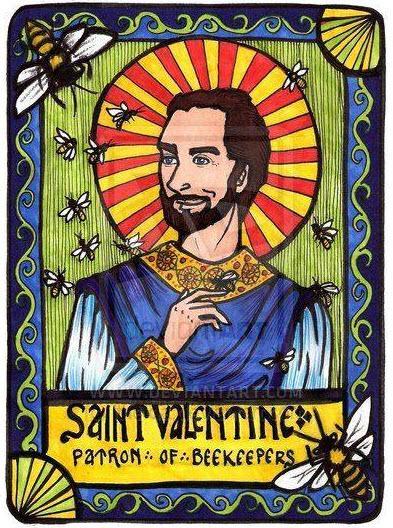Love is often described as sweet, and there’s a delightful connection between love and honey that goes beyond mere metaphor. Did you know that St. Valentine, the patron saint of love, was also associated with beekeeping? In this blog post, we’ll explore the intriguing history of St. Valentine’s connection to beekeeping and unravel the sweet symbolism of honey in love, including the origin of the term “honeymoon.”
St. Valentine: The Beekeeping Patron Saint:
St. Valentine, a mysterious figure with roots in ancient Rome, is widely celebrated as the patron saint of lovers. What many may not be aware of is his unique connection to beekeeping. Legend has it that St. Valentine had a deep affinity for bees and their hives. Some tales even suggest that he possessed a miraculous ability to communicate with bees, fostering a harmonious relationship with these industrious insects.
The Beekeeping Connection
The association between St. Valentine and beekeeping can be traced back to the belief that bees are symbolic of love, community, and diligence. In medieval times, bees were regarded as messengers of the divine, carrying the essence of love from one person to another. St. Valentine’s connection to beekeeping thus reinforces the idea that love, like the industrious honeybee, requires care, nurturing, and dedication.
Honey: The Nectar of Love:
Honey, produced by bees with meticulous precision, has long been revered for its natural sweetness. In the realm of love, honey symbolizes the sweet moments that make a relationship special. Its golden hue and unique flavor have made honey a metaphor for the richness and purity of love. In various cultures, honey has been used in love potions and rituals, highlighting its association with romance and affection.
The Origin of “Honeymoon“:
Ever wondered about the origin of the term “honeymoon”? It is believed to have roots in ancient traditions where newlyweds would consume honey-based mead, a fermented honey beverage, for a lunar month after marriage. This practice was thought to bring sweetness and fertility to the newlyweds, setting the stage for a harmonious and fruitful union. The term “honeymoon” encapsulates the initial, blissful phase of marriage, marked by the sweetness of love.
Honeyed Metaphors in Love:
Throughout history, poets and writers have drawn upon the imagery of honey to express the intensity and sweetness of love. Phrases like “honeyed words” and “sweet as honey” are common in love poetry, emphasizing the enduring connection between honey and romantic affection.
Honey-Lemon Martini:
Ingredients:
2 ounces vodka
1 ounce fresh lemon juice
1/2 ounce honey syrup (1:1 ratio of honey to water)
Ice cubes
Lemon twist for garnish
Instructions:
In a shaker, combine vodka, fresh lemon juice, and honey syrup.
Add ice cubes to the shaker and shake well until the mixture is chilled.
Strain the cocktail into a martini glass.
Garnish with a twist of lemon for an extra burst of citrus aroma.
Conclusion:
St. Valentine, the beekeeping patron saint, adds a unique and enchanting dimension to the celebration of love. The symbolism of honey in love, from the sweet nectar of relationships to the origin of the term “honeymoon,” reflects the universal recognition of love as a precious, delicate, and nurturing aspect of life. So, as we celebrate St. Valentine’s Day, let’s remember the sweet legacy of this beekeeping saint and savor the richness of love, much like the golden elixir crafted by the diligent bees.
Sources
1




